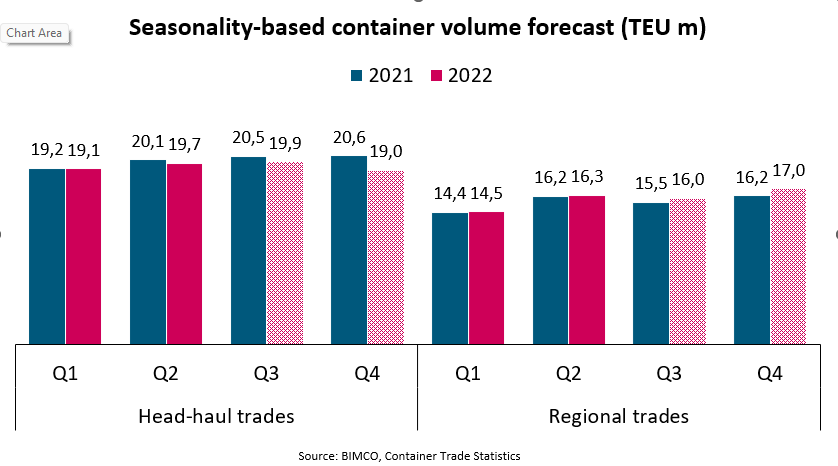Head-haul and regional container trade volumes fall 1.5% m/m in July
In July, the combined head-haul and regional trade volumes fell 1.5% m/m but were up 1.5% y/y. While this initially seems to be a relative improvement in volumes, compared to first half results, the figure appears in a different light when historical seasonality is considered.
As an example, in the Far East to North America trade lane, volumes in July have historically been on average 7.0% higher than June volumes due to the beginning of the peak season. However, this year volumes were 3.3% lower in July than in June. Applying historical seasonality, volumes should have been nearly 200,000 TEU and 10.6% higher than actual volumes.
Using the same principle for all head-haul and regional trade lanes, the combined July volumes should under normal circumstances have been 3.3% higher; 4.3% higher in head-haul trades and 1.9% in regional trades. Overall, volumes would then have been 4.9% higher than July 2021 instead of 1.5%. This is partly because it in 2021 was the first time in recent years that volumes in July were lower than in June.
Applying the same seasonality-based calculation to the rest of 2022, the full year volume estimate ends at 77.8 million TEU and 63.7 million TEU for head-haul and regional trades respectively. In total, that would leave the combined volumes at 141.5 million TEU and 1.3 million TEU lower than in 2021 (a reduction of 0.9%). Head-haul volumes would be down 3.3% y/y while regional volumes would be up 2.3% y/y.
Focusing on the rest-of-year period from August to December, the calculation indicates that combined head-haul and regional trade volumes will be down by 1.9% y/y. From a congestion perspective it is interesting to note a 10.7% y/y and 8.2% y/y fall in import volumes to the Europe and Mediterranean region and North America respectively.
Considering the risk of energy shortages in Europe during winter and that conditions for consumers and businesses are likely to get worse before they get better as the year progresses, it is possible that volumes could end even lower.
Though we appreciate that this approach to forecasting rest-of-year volumes may be somewhat simplistic, the overall forecast does tally with the economy-based forecasts in our recently published Container Market Overview and Outlook report. The prediction will most likely not end up 100% accurate, but we do believe the overall trend will end up correct, confirming a very muted peak season in key head-haul trades and lower Q4 volumes in line with normal seasonality.
Feedback or a question about this information?
BIMCO's Shipping number of the week
- Dry bulk newbuild contracting fell 34.2%, despite a strong market
- Newbuilding prices climb 3% to highest level in 16 years
- Charter owners’ share of fleet has fallen to 40%, lowest since 2002
- Dry bulk sailing distances jump 31% for routes using the Panama Canal
- Peak in China’s coal demand in sight as renewables jump 12%
ELSEWHERE ON BIMCO
Contracts & Clauses
All of BIMCO's most widely used contracts and clauses as well as advice on managing charters and business partners.
Learn about your cargo
For general guidance and information on cargo-related queries.
BIMCO Publications
Want to buy or download a BIMCO publication? Use the link to get access to the ballast water management guide, the ship master’s security manual and many other publications.




